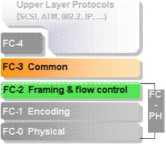9818247290
SAN Security Protocols and Mechanisms

Exhibit 6: Fibrę Channel Protocol Stack
The lowest level (FC-0) defines the physical link in the system, including the fibrę, connectors, optical and electrical parameters for a variety of data rates. FC-1 defines the transmission protocol including serial encoding and decoding rules, special characters and error control.
The Signaling Protocol (FC-2) level serves as the transport mechanism of Fibrę Channel. It defines the framing rules of the data to be transferred between ports, mechanisms for controlling the different service classes and the means of managing the sequence of a data transfer.
The FC-3 level of the FC standard is intended to provide the common services reąuired for advanced features such as:
• Striping -To multiply bandwidth using multiple ports in parallel to transmit a single information unit across multiple links.
• Hunt groups - The ability for morę than one port to respond to the same alias address. This improves efficiency by decreasing the chance of reaching a busy port.
• Multicast
FC-3 Layer is the one initially thought to be also used for encryption or compression services, however latest development have put these services to the Layer 2 of a FC architecture as it will be described later. FC-4, the highest level in the FC structure defines the application interfaces that can execute over Fibrę Channel. It specifies the mapping rules of upper layer protocols such as SCSI, ATM, 802.2 or IP using the FC levels below.
2.5 Fibrę Channel over TCP/IP
Fibrę Channel Over TCP/IP (FCIP) protocol is described in the IETF draft standard as the mechanisms that allow the interconnection of islands of Fibrę Channel storage area networks over IP-based networks to form a unified storage area network in a single Fibrę Channel fabric. Encapsulation of the FC frames which are carrying SCSI frames on top of the TCP is illustrated in Exhibit 7.

Exhibit 7: FCIP Encapsulation.
Wyszukiwarka
Podobne podstrony:
SAN Security Protocols and Mechanisms 13 4.1.3 Fibrę Channel Security Protocols To address additiona
SAN Security Protocols and Mechanisms 14 4.1.3.1.2 Fibrę Channel Authentication Protocol Fibrę Chann
SAN Security Protocols and Mechanisms The invention of a Fibrę Channel (FC) has opened a complete ne
SAN Security Protocols and Mechanisms FCIP transports Fibrę Channel data by creating a tunnel betwee
SAN Security Protocols and Mechanisms Index of Exhibits Exhibit 2: NAS
SAN Security Protocols and Mechanisms 10 networks, allowing a commodity IP network to function in a
SAN Security Protocols and Mechanisms 3.3 Access Control and Authentication Another critical aspect
SAN Security Protocols and Mechanisms 12 One host or storage device could also belong to a multiple
SAN Security Protocols and Mechanisms 15 4.1.3.2FC-SP per frame confidentiality and integrity Recogn
SAN Security Protocols and Mechanisms 16 FC-2 Payload: 0-528 Transmission
SAN Security Protocols and Mechanisms 17 • Data Origin Authentication The IPsec re
SAN Security Protocols and Mechanisms endpoints can be determined, the true source and destination e
SAN Security Protocols and Mechanisms 19 An iSCSI node must also support Internet Key Exchange (IKE)
SAN Security Protocols and Mechanisms_2_ Storage Area Networks Security Protocols and Mechanisms Ind
SAN Security Protocols and Mechanisms 20 6 Futurę directions Storage security is still evolving topi
SAN Security Protocols and Mechanisms Storage Area Networks Security Protocols and Mechanisms 1 Intr
SAN Security Protocols and Mechanisms Storage or shortly NAS. NAS architecture consist of a dedicate
SAN Security Protocols and Mechanisms iSCSI enables SCSI-3 commands to be encapsulated in TCP/IP pac
00322 ?b73d4dcbb3956a7a53bceacac34fb9 Optimizing Defect Levels and Losses from Gage Errors 325 Figu
więcej podobnych podstron